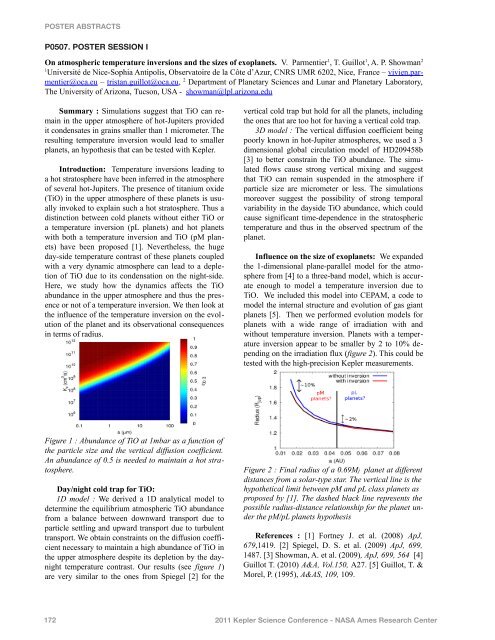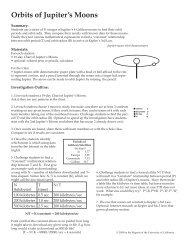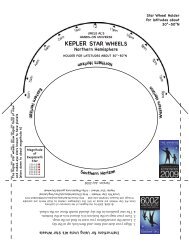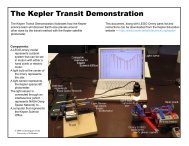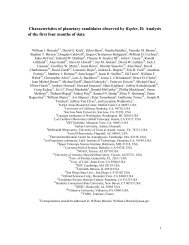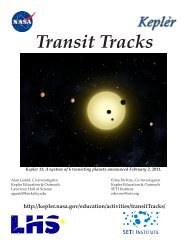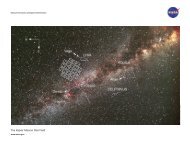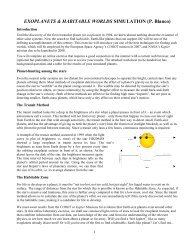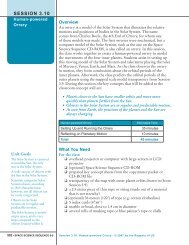Poster Abstracts - Kepler - NASA
Poster Abstracts - Kepler - NASA
Poster Abstracts - Kepler - NASA
- No tags were found...
Create successful ePaper yourself
Turn your PDF publications into a flip-book with our unique Google optimized e-Paper software.
POSTER ABSTRACTSP0507. POSTER SESSION IOn atmospheric temperature inversions and the sizes of exoplanets. V. Parmentier 1 , T. Guillot 1 , A. P. Showman 21Université de Nice-Sophia Antipolis, Observatoire de la Côte d’Azur, CNRS UMR 6202, Nice, France – vivien.parmentier@oca.eu– tristan.guillot@oca.eu, 2 Department of Planetary Sciences and Lunar and Planetary Laboratory,The University of Arizona, Tucson, USA - showman@lpl.arizona.eduSummary : Simulations suggest that TiO can remainin the upper atmosphere of hot-Jupiters providedit condensates in grains smaller than 1 micrometer. Theresulting temperature inversion would lead to smallerplanets, an hypothesis that can be tested with <strong>Kepler</strong>.Introduction: Temperature inversions leading toa hot stratosphere have been inferred in the atmosphereof several hot-Jupiters. The presence of titanium oxide(TiO) in the upper atmosphere of these planets is usuallyinvoked to explain such a hot stratosphere. Thus adistinction between cold planets without either TiO ora temperature inversion (pL planets) and hot planetswith both a temperature inversion and TiO (pM planets)have been proposed [1]. Nevertheless, the hugeday-side temperature contrast of these planets coupledwith a very dynamic atmosphere can lead to a depletionof TiO due to its condensation on the night-side.Here, we study how the dynamics affects the TiOabundance in the upper atmosphere and thus the presenceor not of a temperature inversion. We then look atthe influence of the temperature inversion on the evolutionof the planet and its observational consequencesin terms of radius.vertical cold trap but hold for all the planets, includingthe ones that are too hot for having a vertical cold trap.3D model : The vertical diffusion coefficient beingpoorly known in hot-Jupiter atmospheres, we used a 3dimensional global circulation model of HD209458b[3] to better constrain the TiO abundance. The simulatedflows cause strong vertical mixing and suggestthat TiO can remain suspended in the atmosphere ifparticle size are micrometer or less. The simulationsmoreover suggest the possibility of strong temporalvariability in the dayside TiO abundance, which couldcause significant time-dependence in the stratospherictemperature and thus in the observed spectrum of theplanet.Influence on the size of exoplanets: We expandedthe 1-dimensional plane-parallel model for the atmospherefrom [4] to a three-band model, which is accurateenough to model a temperature inversion due toTiO. We included this model into CEPAM, a code tomodel the internal structure and evolution of gas giantplanets [5]. Then we performed evolution models forplanets with a wide range of irradiation with andwithout temperature inversion. Planets with a temperatureinversion appear to be smaller by 2 to 10% dependingon the irradiation flux (figure 2). This could betested with the high-precision <strong>Kepler</strong> measurements.Figure 1 : Abundance of TiO at 1mbar as a function ofthe particle size and the vertical diffusion coefficient.An abundance of 0.5 is needed to maintain a hot stratosphere.Day/night cold trap for TiO:1D model : We derived a 1D analytical model todetermine the equilibrium atmospheric TiO abundancefrom a balance between downward transport due toparticle settling and upward transport due to turbulenttransport. We obtain constraints on the diffusion coefficientnecessary to maintain a high abundance of TiO inthe upper atmosphere despite its depletion by the daynighttemperature contrast. Our results (see figure 1)are very similar to the ones from Spiegel [2] for theFigure 2 : Final radius of a 0.69Mj planet at differentdistances from a solar-type star. The vertical line is thehypothetical limit between pM and pL class planets asproposed by [1]. The dashed black line represents thepossible radius-distance relationship for the planet underthe pM/pL planets hypothesisReferences : [1] Fortney J. et al. (2008) ApJ,679,1419. [2] Spiegel, D. S. et al. (2009) ApJ, 699,1487. [3] Showman, A. et al. (2009), ApJ, 699, 564 [4]Guillot T. (2010) A&A, Vol.150, A27. [5] Guillot, T. &Morel, P. (1995), A&AS, 109, 109.1722011 <strong>Kepler</strong> Science Conference - <strong>NASA</strong> Ames Research Center


